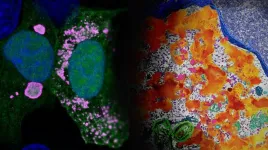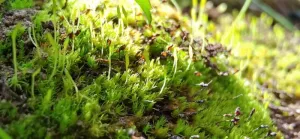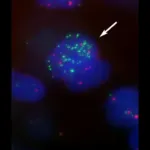(Press-News.org) LA JOLLA, CA—New research in the journal Nature Communications gives scientists an important window into how Ebola virus replicates inside host cells. The study, led by scientists at La Jolla Institute for Immunology (LJI), reveals the inner workings of "viral factories," clusters of viral proteins and genomes that form in host cells.
The research team, which included experts from Scripps Research and UC San Diego School of Medicine, found that Ebola virus's replication machinery forms fascinating microscopic structures that become viral factories. By understanding the architecture and function of these microscopic manufacturing hubs, researchers may be closer to developing new therapies that interrupt the Ebola virus life cycle and prevent severe disease.
“We are imaging these fluid and dynamic assembly centers for the first time. Understanding how they work and what they require gives us the information needed to defeat them," says LJI President and CEO Erica Ollmann Saphire, Ph.D., senior author of the new study.
What is a viral factory?
Scientists first spotted what would turn out to be "virus factories" in virus-infected animal cells back in the 1960s, but they didn't know what they were seeing. Within a sea of normal cellular proteins, these areas looked like fuzzy splotches.
"People had already seen that Ebola-infected cells had these 'inclusions,'" says LJI Postdoctoral Researcher Jingru Fang, Ph.D., first author of the new study. For a long time, scientists thought of these "inclusions" as helpful visual indicators of infection, without understanding their true purpose. "But in fact, these ‘inclusion bodies’ actively gather an enormous quantity of viral proteins and viral RNAs."
Many viral pathogens, including rabies virus and RSV (respiratory syncytial virus) form inclusions in host cells, Fang explains. "Recent studies suggest that these cellular inclusions are the site where viruses make their RNA genomes. They are ‘viral factories’ with actual functional purpose: to offer a secured space for viral RNA synthesis," says Fang. "The process of viral RNA synthesis involves flux of viral building blocks. This means molecules gathered inside viral factories should be able to move freely rather than being static."
For the new study, Saphire, Fang and their colleagues wondered: Can we observe the movement of viral building blocks directly in living cells?
Fang began by tagging a viral protein called VP35 with a fluorescent marker that makes the protein glow in the dark. VP35 is a critical component of the viral factory and is important for viral RNA synthesis (and the making of new copies of Ebola virus). Working with imaging experts in the LJI Microscopy and Histology Core, Fang followed the glowing proteins in live cells, which express a simplified and non-infectious version of Ebola viral factories.
Under the microscope, Fang and colleagues could indeed see and even measure how molecules move inside the viral factories formed in host cells. This finding added evidence that viral proteins are clumping together like droplets so they can churn out the proteins needed to help the virus replicate. Those mysterious inclusions really are viral factories. The researcher dubbed these "droplet-like" viral factories.
Then the scientists saw something odd. Some of the glowing proteins didn't gather into clumps. Instead, they joined up with a smattering of other viral proteins, creating a fluorescent swirl that evoked van Gogh's "Starry Night." These trails of viral proteins still had the right ingredients to replicate Ebola virus, so the scientists dubbed them "network-like" viral factories.
"These are two different flavors of the viral factory," says Fang. "People have mostly focused on the droplet-like form, which is the majority, and not paid too much attention to this other form."
Besides their shapes, there was a key difference between the two factories. It appeared the network-like factories had the right ingredients for the incoming Ebola virus to express its genes, but they didn't actually produce virus progenies.
A multi-tasking machine
Next, the researchers looked at a key player in infection: a protein called virus polymerase. Polymerase is a multifunctional nanomachine that comes with the virus. This machine not only copies the Ebola virus genomic material, it also transcribes the viral genome into messenger RNAs, which instruct infected cells to produce loads of viral proteins. The researchers wanted to understand how this viral machine functions inside viral factories.
Ebola virus polymerase is already known as a hard-working protein—all Ebola viral proteins have to be. Ebola virus is a highly efficient pathogen because it gets by with just seven genes (humans have more than 20,000 genes). Saphire has led research showing that Ebola virus survives by making proteins that can transform and take on different jobs during the course of infection.
Just last year, Saphire, Fang, and collaborators published a related discovery that viral polymerase actually harnesses a druggable human protein to help the virus replicate its genome. The team reported that while polymerase is essential for viral replication, the polymerase doesn't actually jump into action until infection is well underway.
This work was important for understanding how polymerase stepped into action, but scientists also needed to know where polymerase was active. Fang knew it would be important to look at what polymerase might be up to in viral factories.
The researchers discovered that polymerase actually builds its own special structures inside viral factories. Many copies of polymerase gather in small bundles, called foci. The researchers found that these bundles spread out when a droplet-like viral factory starts replicating viral material.
Scientists aren't sure exactly why polymerase needs to form bundles before it can do its job, but the spatial arrangement of the bundles must be important. As Fang points out, the idea of many small components coming together to build a structure isn't a new concept in nature. "You can use a beehive or coral reef as the analogy to help understand why a specific spatial arrangement is important for a biological system to function," she says.
With this finding, scientists now know how to find different kinds of viral factories and how polymerase organizes itself down on the factory floor.
Fighting back
More than 30 human pathogens are known to assemble viral factories inside host cells, including respiratory syncytial virus (RSV) and even rabies virus. With this new view of Ebola's viral factories, the scientists are curious whether other viruses construct similar forms of viral factories—and whether other viruses use their own versions of polymerase in the same way.
"If that's true, maybe we can target the feature of viral factory formation that has been shared by multiple different viruses," says Fang.
Going forward, Fang would also like to study how Ebola virus forms viral factories in different kinds of host cells. Do these viral factories look different in cells from animals (such as the virus’s natural hosts, the fruit bats) that can carry the virus around without getting sick? "Can we find some explanation for host-specific viral pathogenesis?" she asks.
The new study also demonstrates the importance of collaboration across San Diego's Torrey Pines Mesa. The LJI team worked closely with Scripps Research Professor Ashok Deniz, Ph.D., and UC San Diego Professor Mark H. Ellisman, Ph.D., Director of the National Center for Microscopy and Imaging Research.
"The combination of state-of-the-art tools available on the Torrey Pines Mesa allowed us to combine the biophysical characterization with the human health insight," says Saphire
Additional authors of the study, "Spatial and functional arrangement of Ebola virus polymerase inside phase-separated viral factories," include Guillaume Castillon, Sebastien Phan, Sara McArdle, Chitra Hariharan, and Aiyana Adams.
This study was supported by the National Institute of Health (grants NIH S10OD021831, R24GM137200, and S10OD021784), an Imaging Scientist grant (2019‐198153) from the Chan Zuckerberg Initiative, LJI institutional funds, and the Donald E. and Delia B. Baxter Foundation Fellowship.
DOI: 10.1038/s41467-023-39821-7
END
A new look inside Ebola's 'viral factories'
LJI researchers reveal a hidden side of how Ebola virus replicates inside host cells
2023-08-09
ELSE PRESS RELEASES FROM THIS DATE:
Exercise apps a good prescription to boost healthcare workers' mental health
2023-08-09
Simple home workouts using exercise apps can effectively reduce depressive symptoms in healthcare workers and could be a major tool to combat the global mental health crisis in the sector, says new University of British Columbia research.
The study, published today in JAMA Psychiatry, divided participants into either a waitlisted control group or an exercise group who were given free access to a suite of home exercise apps called DownDog, that included yoga, cardio and strength training. They were asked to aim for at least 80 minutes of moderate-intensity ...
Then vs. now: Did the Horn of Africa reach a drought tipping point 11,700 years ago?
2023-08-09
New research suggests that the Horn of Africa is likely to become even drier, not wetter in the future as predicted by most climate models.
‘Wet gets wetter, dry gets drier’. That mantra has been used for decennia to predict how global warming will affect the hydrological cycle in different world regions. But if climate models predict that much of tropical Africa will enjoy a future with wetter weather, then why does it keep getting drier in certain parts of the African tropics, like the Horn of Africa? An international team of researchers ...
Resilient biomedical scientists’ careers took a hit during pandemic
2023-08-09
First study to measure resilience in biomedical scientists during the pandemic
Sixty-one percent of study participants said they experienced a setback during pandemic
‘You can be as resilient as you want, but certain structural factors can hinder your professional advancement’
CHICAGO --- When COVID-19 presented the world with the greatest health challenge in modern history, it was biomedical scientists who stepped up to develop diagnostic testing and vaccines to slow the spread of the disease.
But how did these in-demand scientists fare psychologically and in their careers amid pandemic pressures such as juggling ...
Engineered probiotic developed to treat multiple sclerosis
2023-08-09
Brigham researchers are working on a new approach to target autoimmunity in the brain leverages designer bacteria to make treatment safer and more effective
Researchers from Brigham and Women’s Hospital, a founding member of the Mass General Brigham healthcare system, have designed a probiotic to suppress autoimmunity in the brain, which occurs when the immune system attacks the cells of the central nervous system. Autoimmunity in the brain is at the core of several diseases, including multiple sclerosis. In a new study, researchers demonstrated the treatment’s potential using preclinical models of these diseases, finding that the technique offered a more precise ...
There and back again: how neurons make room for growth in a developing organ
2023-08-09
To function properly, organs require a precise number of cells and a functional architecture, which are established during embryogenesis. Embryos are proficient multitaskers; they grow, and acquire shape and functional architecture all at once. Despite a lot of research on embryo development, scientists do not yetfully grasp how embryos orchestrate all these different tasks in space and time to ensure the formation of healthy organs. This was ...
Oldest extant plant has adapted to extremes and is threatened by climate change
2023-08-09
The rare moss Takakia has adapted over millions of years to a life at high altitudes. An international research team led by Prof. Dr. Ralf Reski from the University of Freiburg and Prof. Dr. Yikun He from the Capital Normal University / China has now discovered exactly how it has developed the ability to survive frost and life-threatening high UV radiation. In the renowned journal Cell, they describe the genetic traits that protect the moss from extreme environmental conditions. At the same time, they document how climate change greatly altered the natural habitat of this highly specialized species within just a few years.
The ...
Drinking alcohol not likely to increase risk of a breast cancer recurrence
2023-08-09
A Kaiser Permanente study provides new information that may help oncologists answer one of the most common questions they hear from breast cancer survivors: Is it safe to drink alcohol?
The new study, published August 9 in Cancer, is the largest prospective study to look at short-term alcohol use after breast cancer. The findings suggest drinking alcohol is not associated with an increased risk of breast cancer recurrence or dying from the disease.
“We know that women who drink alcohol are at increased ...
New machine-learning method may aid personalized cancer therapy
2023-08-09
FOR IMMEDIATE RELEASE
Deep-learning technology developed by a team of Johns Hopkins engineers and cancer researchers can accurately predict cancer-related protein fragments that may trigger an immune system response. If validated in clinical trials, the technology could help scientists overcome a major hurdle to developing personalized immunotherapies and vaccines.
In a study published July 20 in the journal Nature Machine Intelligence, investigators from Johns Hopkins Biomedical Engineering, the Johns Hopkins Institute for Computational Medicine, the Johns Hopkins Kimmel Cancer Center and the Bloomberg~Kimmel Institute for Cancer Immunotherapy show that ...
Childhood cancer: "New" immune system responds better to therapy
2023-08-09
(Vienna, 9.8.2023) Scientists at St. Anna Children's Cancer Research Institute and the Eberhard Karls University of Tübingen have shown that immunotherapy after stem cell transplantation effectively combats certain nerve tumors in children. Crucially, stem cells from a parent provide children with a new immune system that responds much better to immunotherapies. These results of an early clinical trial were published in the prestigious Journal of Clinical Oncology.
Childhood tumors of the nervous system, known as neuroblastomas, are associated with an unfavorable prognosis ...
2024 HFSP Nakasone Award nominations are open
2023-08-09
The Human Frontier Science Program (HFSP) has published the new call for the 2024 HFSP Nakasone Award. Until September 30th, the global scientific community is invited to submit their nominations for this prestigious award.
The HFSP Nakasone Award recognizes groundbreaking contributions and breakthrough discoveries in the life sciences. The award celebrates exceptional achievements in scientific excellence, particularly those that have propelled the boundaries of biological knowledge forward.
In its 13th ...
LAST 30 PRESS RELEASES:
Manta rays create mobile ecosystems, study finds
Study: Mixed results in using lipoic acid to treat progressive multiple sclerosis
Norbert Holtkamp appointed director of Fermi National Accelerator Laboratory
New agentic AI platform accelerates advanced optics design
Biologists discover neurons use physical signals — not electricity — to stabilize communication
Researchers discover that a hormone can access the brain by hitchhiking
University of Oklahoma researcher awarded funding to pursue AI-powered material design
Exploring how the visual system recovers following injury
Support for parents with infants at pediatric check-ups leads to better reading and math skills in elementary school
Kids’ behavioral health is a growing share of family health costs
Day & night: Cancer disrupts the brain’s natural rhythm
COVID-19 vaccination significantly reduces risk to pregnant women and baby
The role of vaccination in maternal and perinatal outcomes associated with COVID-19 in pregnancy
Mayo Clinic smartwatch system helps parents shorten and defuse children's severe tantrums early
Behavioral health spending spikes to 40% of all children’s health expenditures, nearly doubling in a decade
Digital cognitive behavioral treatment for generalized anxiety disorder
Expenditures for pediatric behavioral health care over time and estimated family financial burden
Air conditioning in nursing homes and mortality during extreme heat
The Alps to lose a record number of glaciers in the next decade
What makes a good proton conductor?
New science reporting guide published for journalists in Bulgaria
New international study reveals major survival gaps among children with cancer
New science reporting guide published for journalists in Turkey
Scientists develop a smarter mRNA therapy that knows which cells to target
Neuroanatomy-informed brain–machine hybrid intelligence for robust acoustic target detection
Eight SwRI hydrogen projects funded by ENERGYWERX
The Lundquist Institute and its start-up company Vitalex Biosciences Announces Strategic Advancement of Second-Generation fungal Vaccine VXV-01 through Phase 1 Trials under $40 Million Competitive Con
Fine particles in pollution are associated with early signs of autoimmune disease
Review article | Towards a Global Ground-Based Earth Observatory (GGBEO): Leveraging existing systems and networks
Penn and UMich create world’s smallest programmable, autonomous robots
[Press-News.org] A new look inside Ebola's 'viral factories'LJI researchers reveal a hidden side of how Ebola virus replicates inside host cells





